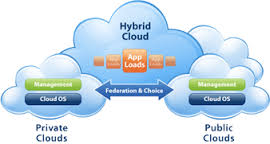Cloud computing is certainly a hot technology that is much in gossip these days. However, it is the hybrid version of this computing that is gaining more attention and considerations from IT professionals across the world. Firms are seriously thinking of implementing hybrid clouds for accomplishing optimal benefits from this model. A hybrid cloud model is a framework that is designed to curtail the errors and extend the efficiency of the network by gaining the pros of both public and private clouds. Although this seems to very beneficial because it offers the best of both the worlds, it is a fact that no technology or model is free of risks. Firms can incur losses if they misuse or are unaware of the downside of this technology.
Overview of Hybrid Clouds
In general, cloud computing means using public clouds that are shared by innumerable customers across the globe. The providers sell resources such as bandwidth and storage space at cheaper rates than the physical servers. Although this is affordable, it has some issues with regards to security, availability, and accessibility. For example, firms would not like to host confidential or sensitive data on a public cloud. For this, they would prefer their personal private servers. This gave rise to what is known as the private cloud. Being similar in working when compared to public clouds, private clouds are exclusively owned by the firm and can be firewalled for security and better performance.
When these two types of clouds are used as a judicious mix for obtaining maximum advantage from each of them, a hybrid model is formed. While public clouds are meant for less vital or confidential tasks, private clouds are meant for sensitive tasks. In this way, a hybrid cloud model is most preferred by those who do not wish to use the cloud technology on a large scale.
Benefits of Hybrid Models
A hybrid cloud environment is designed for scaling the needs of a firm swiftly. Because there are many standardized processes for obtaining synchronization amongst different clouds, the model is ideal for executing heavy projects that in-house servers cannot handle. By implementing this model, the company enjoys saving the cost of special server hardware. Further, a firm can operate hybrid clouds from any part of the world and at any time, which makes globalization easier and quicker for businesses looking for internationalization. Moreover, even during the times of outages, the environment ensures reliable connections. Above all, the technology is quite affordable than the investment required in managed hosting providers.
Issues Involved in Hybrid Models
The prevalent, considerable extent of insecurity is a major issue that makes several firms to step back from welcoming this model. Nevertheless, experts agree that data in the model is totally secure just as it would be on a physical server. One of the security tips for these firms is to store the most sensitive data on local servers and store the rest on the cloud. They can further choose to perform critical operations in private data centers, while processing heavy tasks on the cloud.
In a nutshell, the hybrid cloud model is surely a boon for IT firms.
Bio: Lance Gallis is an enterprise application analyst who is serving one of the top IT firms in New Jersey. He has worked with different cloud environments as well as applications since past two years. Currently, Lance has been given a new project wherein he has to set up a hybrid cloud model for increasing the overall efficiency of his firm. Due to this, he is now spending most of his time in understanding hybrid model, its architecture, and its pros and cons. Lance has already become a great fan of cloud computing and is happy to now work on its latest model for ensuring more dynamism, customization, and scalability to his firm.





